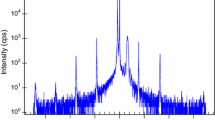Abstract
The current infrared microbolometer technology using vanadium oxide material is not quite as sensitive as a cooled platinum silicide or cooled mercury cadmium telluride or indium antimonide array. The performance factor of the present IR bolometer needs to be improved by at least an order of magnitude to make a bolometric IR device comparable to the cooled detector arrays. I recently reported [1] that thin films of globular proteins such as cytochrome c exhibit a high temperature coefficient of resistance (TCR) value of about 10% as compared with a value of 2.0 to 2.5% normally observed in VOx films. The measurements that were initially reported were taken two weeks after the thin films had been prepared. The measurement of the TCR values presented in this report were taken within three days of the films being prepared. These TCR values are very high, approximately 35% for temperatures between 25 and 60°C, and they have a sheet resistance around 1 to 2 Ω/cm2 with a current of 1 mA. The values of TCR were very uniform over the wafer surface, but the values varied slightly from wafer to wafer. It appears that a cytochrome c monolayer on metal oxide semiconductor (CMOS) electronics could generate miniaturized, uncooled IR detector arrays that would be suitable for military and commercial applications that require very high performance and low-power drain. With these high TCR values, biological uncooled devices will have the potential for long-range thermal imaging applications comparable to cooled detectors.
I have also examined the sheet resistance of the protein layer with an increase in the bias current near ambient temperature. I found that the sheet resistance of cytochrome c rapidly goes towards the negative values as the bias current is increased. On the other hand, TCR characteristics remained unchanged with an increase in bias current. This is a very interesting phenomenon that has never been reported in biomolecules. I am making further explorations into the electrical properties of many proteins for possible device applications.
Similar content being viewed by others
Author information
Authors and Affiliations
Additional information
Received: 8 February 1999/Reviewed and accepted: 9 February 1999
Rights and permissions
About this article
Cite this article
Deb, K. Update: a protein microbolometer for focal plane arrays. Mat Res Innovat 3, 66–68 (1999). https://doi.org/10.1007/s100190050126
Issue Date:
DOI: https://doi.org/10.1007/s100190050126




